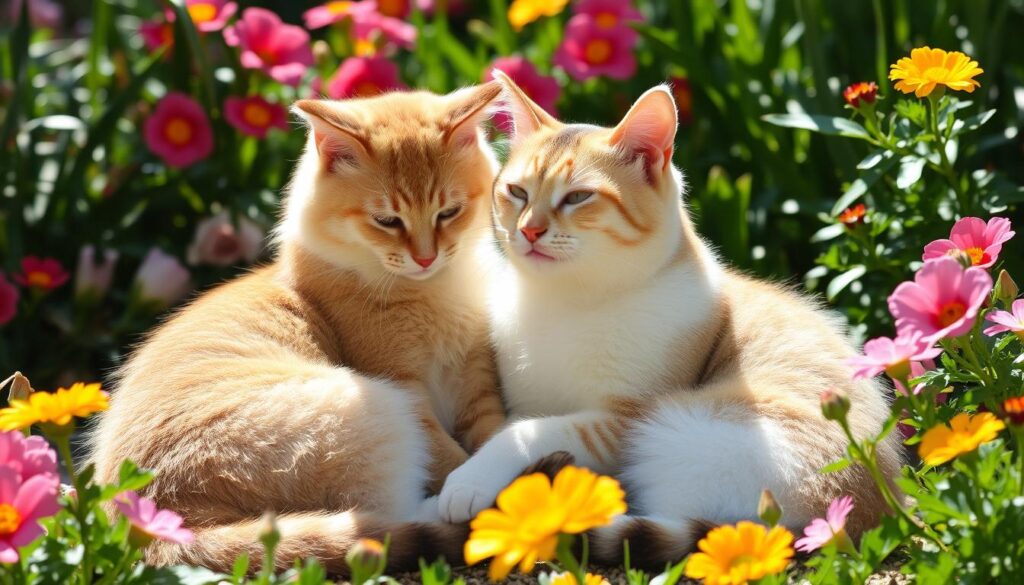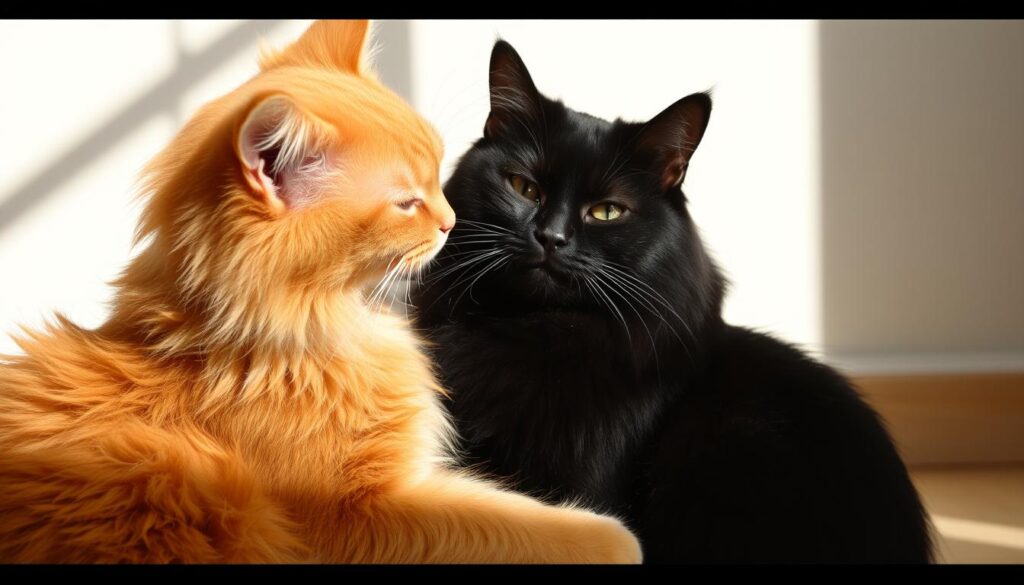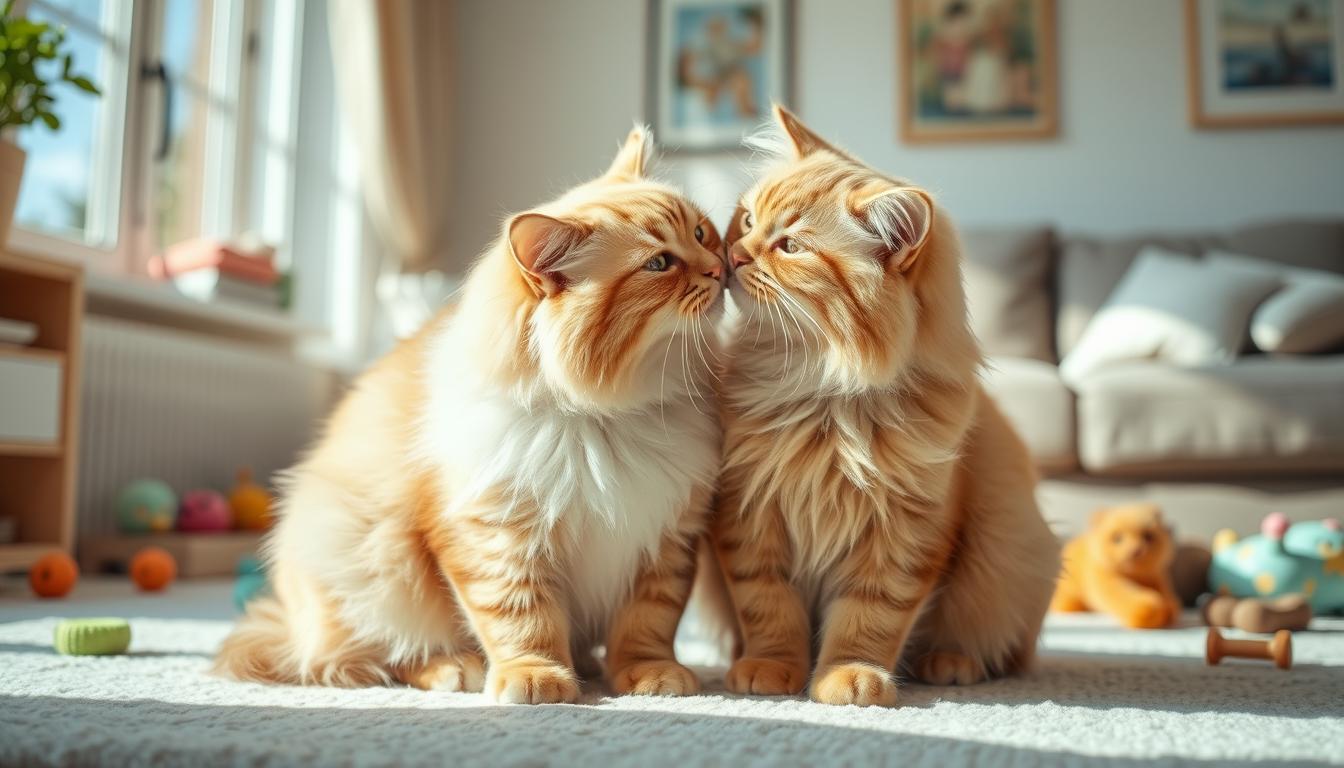Watching your cats groom each other is heartwarming. It’s more than just cleaning; it shows their deep bond. This behavior, called allogrooming, reveals the strong connections cats have with each other.
Cats are social animals, and grooming is key to their community. They share scents through gentle licks, showing they belong together. The purrs they make during grooming show they’re happy and feel safe with each other.
Grooming each other does more than show love. It helps cats stay clean and warm. It also helps them sort out who’s boss and avoid fights. This simple act is vital for their social lives.
Table of Contents
Understanding the Science Behind Cat Grooming Behavior
Cats are known for their detailed grooming habits. But, there’s more to it than just staying clean. Cat allogrooming, or cats grooming each other, is key to their social bonding and identity. Let’s explore the fascinating world of cat grooming and why they do it.
The Role of Scent Glands in Grooming
Cats have scent glands all over their bodies. These glands are found on their faces, chins, and near their mouths. They also have them between their paw pads, at the base of their tails, and near their anuses. When cats groom each other, these glands help mark their scent and recognize each other.
By spreading their scent, cats create a shared identity. This strengthens their bond and group dynamics.
How Cats Use Their Tongue for Grooming
Cats have tongues with rough, backward-facing barbs. These barbs help remove dirt, debris, and loose hair. This keeps them clean and distributes their natural oils, keeping their fur healthy and shiny.
The Biology of Allogrooming
The act of cat allogrooming is deeply rooted in feline social bonding. When cats groom each other, they exchange scents. This is important for social recognition and strengthening their social ties.
Also, grooming releases endorphins. This creates a pleasurable experience for the cats involved.
| Benefit | Description |
|---|---|
| Scent Marking | Cats mark their territory and establish a shared identity by spreading their unique scent profile during grooming. |
| Social Bonding | Allogrooming helps cats strengthen their social connections and reduce stress, leading to a closer-knit group. |
| Pleasure Release | The act of grooming releases endorphins, creating a positive experience for the cats involved. |
Understanding cat grooming behavior gives us insights into their social dynamics and emotional well-being. By appreciating the many purposes of this behavior, we can better understand their complex communication and interaction.
Why Do Cats Groom Each Other: The Social Connection
Feline social bonding is really interesting, and grooming each other is key. This act, called allogrooming, helps cats feel closer. They share scents, which shows they accept and unite with each other.
Cats in the same home or feral colonies groom a lot. It’s a sign of love, trust, and their place in the group. Grooming also helps prevent fights by turning aggression into something good.
Studies show that bonded cats groom each other more. It makes them feel happy and safe. This cat friendship also keeps their fur clean, especially in hard spots.
“Allogrooming, which is the scientific term for cats grooming each other, is crucial in feline communities, promoting unity and cooperation.”
Grooming also shapes the cat social hierarchy. Dominant cats groom others to show their power. This helps them keep their place in the group.
Mutual grooming is complex and shows the deep social bonds in cats. Understanding this helps us see how cats connect and stay happy together.
The Mother-Kitten Bond: Early Grooming Behaviors
From the moment a kitten is born, the mother cat’s grooming is key. It helps the kitten grow and bond with others. This cat cleaning ritual is both practical and emotional, setting the stage for future cat bonding through grooming.
Stimulating Young Kittens Through Grooming
In the first 3-4 weeks, the mother cat’s grooming helps the kitten. It stimulates the kitten’s urination and defecation, which the kitten can’t do on its own yet. This keeps the kitten clean and teaches it to go to the bathroom correctly.
Teaching Self-Grooming Habits
As kittens grow, the mother cat starts to groom them less. She does this to teach them to groom themselves. This skill is vital for keeping their coat clean and healthy.
The bond between a mother cat and her kittens is strong because of grooming. This cat cleaning ritual keeps kittens healthy and strengthens family ties. It prepares them for cat bonding through grooming as adults.
Creating Group Identity Through Mutual Grooming
Mutual grooming, or allogrooming, is key in forming group identity among cats. It involves exchanging scents, creating a unique group scent. This scent helps cats recognize who is part of their group.
In homes with multiple cats, grooming helps keep peace. Cats share their scents, making a “family” smell. This smell strengthens their bond and sense of belonging.
But allogrooming isn’t just for cats. Primates like chimpanzees and bonobos also do it to build bonds and reduce stress. Birds, such as parrots and pigeons, use it to form pair bonds.
“Allogrooming is a widespread behavior across various animal species that live in social systems, emphasizing its importance in fostering connections, reducing tension, and promoting harmony within animal groups.”
Understanding mutual grooming helps us appreciate our cat’s social lives. It shows how cats communicate and build their social structures. This knowledge deepens our bond with them.

The Role of Allogrooming in Feline Social Hierarchy
Cats are complex social creatures. Their grooming behaviors help establish and maintain their social hierarchy. Allogrooming, or one cat grooming another, signals dominance or submission.
Dominance and Submission Signals
A dominant cat may groom a subordinate as a way to show their power. This grooming is gentle and calming. The subordinate cat may groom back, showing they accept the dominant cat’s status.
Territory Marking Through Grooming
Allogrooming also marks territory, as cats share their scent. This scent-sharing creates a shared group identity. It reduces tension and aggression in multi-cat homes. By grooming each other, cats claim each other as part of their group or territory.
Cats don’t have a strict social hierarchy like some animals. Their social structures are more fluid and complex. Allogrooming helps maintain group harmony and cohesion.
Allogrooming plays a multi-faceted role in feline social hierarchy. It serves as a means of communication, bonding, and territory marking among these fascinating creatures.
Physical Benefits of Mutual Cat Grooming
Cats are very independent and can groom themselves well. But, when they groom each other, it’s very helpful. They can clean parts of their body that are hard to reach, like their head and neck.
This grooming helps keep their fur clean and healthy. It’s especially good for long-haired cats, like Persians, to avoid mats and tangles. Short-haired cats, like Siamese, need less grooming. Cats alone can also stay clean without a friend.
| Grooming Needs by Breed | Grooming Frequency |
|---|---|
| Long-haired cats (e.g., Persians) | More frequent grooming required |
| Short-haired cats (e.g., Siamese) | Less frequent grooming required |
But, too much grooming can mean there’s a problem. It could be allergies, stress, or skin issues. Watch your cat’s grooming habits and see a vet if you notice anything odd.
So, mutual cat grooming is good for their health and looks. Knowing about cat cleaning rituals and cat grooming purposes helps us see how important it is for our pets.

Emotional Aspects of Cat-to-Cat Grooming
Cats groom each other for more than just cleanliness. It’s a way to bond and feel good emotionally.
Release of Feel-Good Hormones
Grooming each other makes cats feel happy. It releases endorphins and oxytocin, just like in humans. This strengthens their friendship and makes them feel content.
Stress Relief Through Grooming
Grooming can calm stressed cats. It’s like a natural therapy for them. But, too much grooming might mean they’re not okay.
Understanding cat grooming shows how deep their social bonds are. It’s key to their happiness and friendship.
When Grooming Leads to Fighting: Understanding Overstimulation
Mutual grooming can make cats closer, but it can also lead to fights. This happens when one cat gets too excited or doesn’t like being groomed. This can make the other cat angry.
It’s key to give each cat its own space. This means separate places for eating, resting, and using the litter box. This reduces fights and stress. Also, having fun toys and places to climb helps keep them happy and calm.
If grooming fights happen a lot, talk to a vet or a cat behavior expert. They can figure out why and help you keep the peace. This way, your cats can live together happily.


1 thought on “Why Do Cats Groom Each Other: Social Bonding Explained”